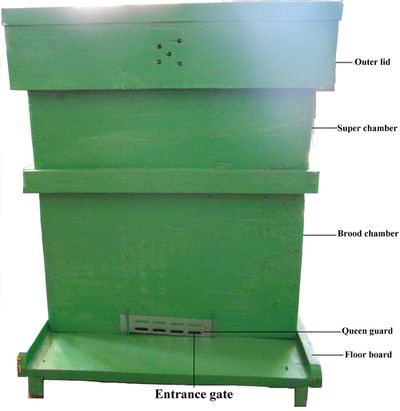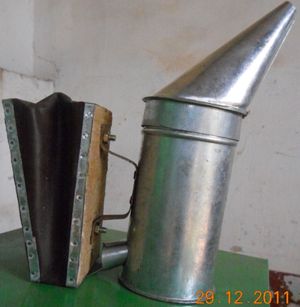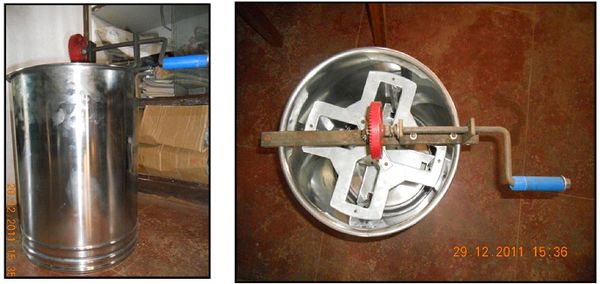Chapter 4: Beekeeping equipment
4.1. Bee-hive/Box
In Uttara Kannada, there are two types of boxes available viz. the standardized ISI marked boxes and locally prepared ones. The ISI boxes are of teak or other high quality timbers, while locally boxes are made of miscellaneous woods. A typical beehive contains various parts like hive stand, floor board, brood chamber, super chamber and outer cover (plate 4.1). The hive stand consists of a wooden pole or iron stand fixed to the ground. On the hive stand is a wooden plank or floor board that makes the floor of the hive which is separable from the hive stand. The brood box or brood chamber sits on this floor. The latter is a larger sized of box inside which eight full-depth wooden frames are arranged vertically and parallel to each other. On each of this frame is fixed a foundation sheet made of waxy material. The bees build the comb on both sides of the foundation sheet. The foundation sheet makes the preparation of bee comb a faster exercise and the combs are almost evenly spaced between the vertical wooden frames. A brood box normally contains one queen bee. The latter lays eggs, placing one each inside a cell of the comb. When the eggs hatch larvae are formed inside the cells and the larvae mature into the adult bees. When the brood chamber is well populated with bees the bee-keeper fixes a super chamber on the top of the brood chamber. Like the brood chamber the super chamber also has eight frames meant for comb making by worker bees. The super chamber is meant for storage of surplus honey and pollen in the cells by the worker bees and not for egg-laying by the queen. So that the queen bee should not enter into the super chamber to lay eggs a mesh work called queen excluder is placed between the brood and super chambers. However, if the queen is a prolific egg layer the bee keeper can use the option of fixing a second brood chamber to the first, before fixing the super chamber. In such cases there will be greater yield of honey because of more number of worker bees gathering nectar. The honey and pollen stored in the brood chamber is meant for only the developing larvae and not for extraction by the bee-keeper. The standard height of the super chamber is three-fourth of the brood chamber. More than one super chamber can be fixed to the brood box if there is more production of honey. If the bee-keeper extracts honey from the hive at short intervals there is no need for fixing a second or third super chamber to the first. Inside the super chamber boxes, beeswax may hang down from the frames. Although the standard super chamber box is designed to hold eight frames, some beekeepers fix only seven frames inside it. So that water should not percolate into the bee box during the rains the super chamber is often roofed with wooden, aluminum or tin roofing. The roof that can be removed like a lid from the top of the super chamber may be flat or slanting. The slanting type is preferred by the local bee-keepers because of the heavy rainfall in Uttara Kannada. This lid has to be provided with few holes on sides for the purpose of ventilation. Towards one side of the brood chamber, just above the floor board, is an opening for the entry and exit of the bees. To prevent the queen bee from flying out of the box a metal plate with few holes that can permit only the entry and exit of the worker bees and drones is fixed to the entrance of the box opening. This slotted metal plate is called as queen guard.

Plate 4.1: A typical bee hive or Bee box
4.2. Smoker
The smoker is a metal cylinder in which a fire is lit to produce smoke (Plate: 4.2). The smoker is attached with a bellow to blow air into the fire. The regulated smoke that comes out of the nozzle is directed into the hive to make the bees docile and less prone to sting.

Plate 4.2: Smoker
4.3. Honey extractor
It consists of a metal drum with a centrifugally rotating device, for the extraction of honey from the frames. Four frames filled with honey from the super-chamber can be placed in the extractor at one time to extract honey by rotating it with the help of a handle (Plate: 4.3). Use of the extractor will not cause any damage to the combs so that they can be placed back in the super chamber after honey extraction.

Plate 4.3: Honey extractor
Other accessories include pollen traps which are used for the collection of surplus pollen. Drone traps which are used for trapping drones and preventing them from re-entering the hive but allowing entry of the workers freely. A knife is used for uncapping cells. A wide mouthed bottle or dish is used for keeping bee food during dearth period. A hive scraper is used for cleaning the floor board, and leather gloves used for handling live frames. The bee keeper is recommended to wear overcoat to avoid bee stings.